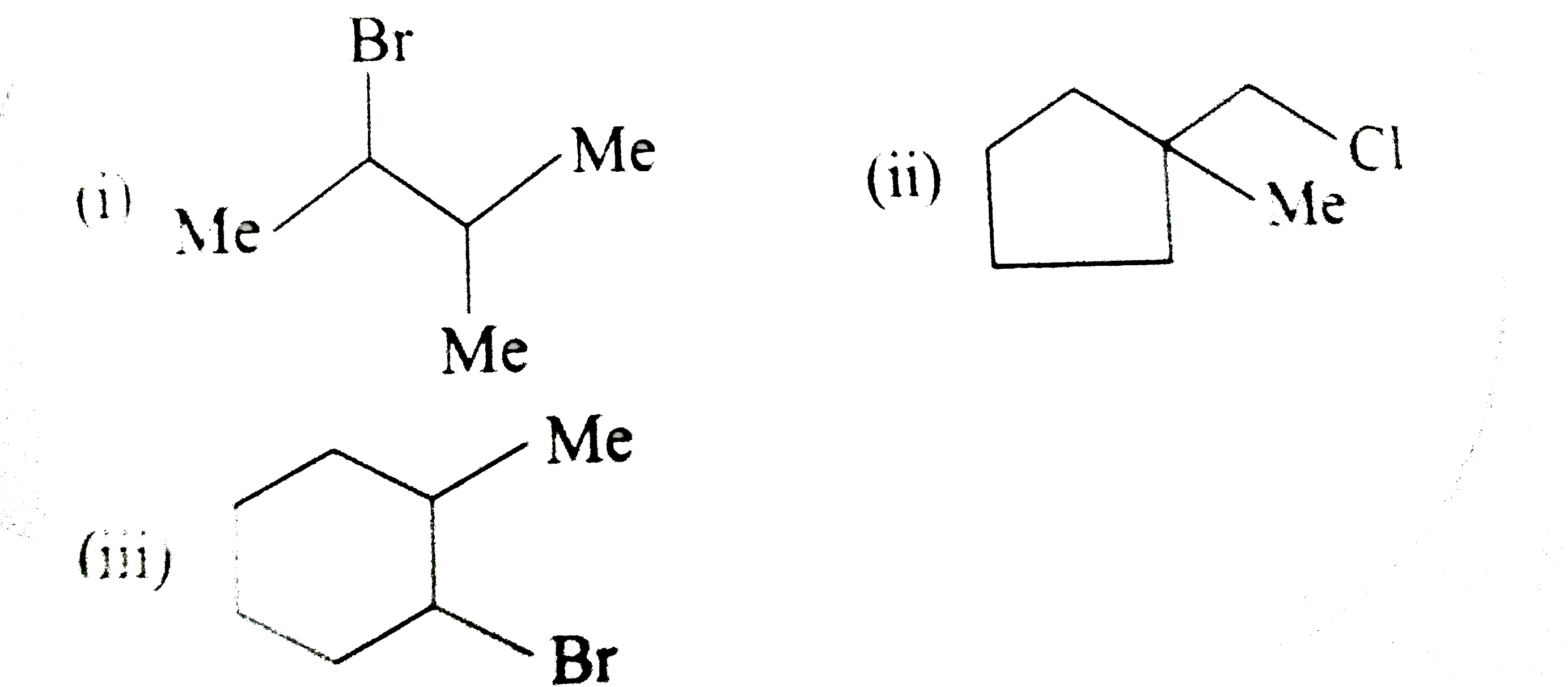An mixture of two organic chlorine compounds was treated with sodium metal in ether solution. Isobutane was obtained as a product. The two chlorine compounds are:
Methyl chloride and propyl chloride
Methyl chloride and ethyl chloride
Isopropyl chloride and methyl chloride
Isopropyl chloride and ehtyl chloride
The correct Answer is:3
To solve the problem of identifying the two organic chlorine compounds that yield isobutane when treated with sodium metal in ether, we can follow these steps:
Step 1: Understand the Reaction
The reaction described is a Wurtz reaction, where two alkyl halides react with sodium metal to form a higher alkane. The general reaction can be represented as:
\( R-X + R'-X + 2Na \rightarrow R-R' + 2NaX \)
where \( R \) and \( R' \) are alkyl groups and \( X \) is a halogen (in this case, chlorine).
Step 2: Identify the Product
The product of the reaction is isobutane, which has the structure:
\( \text{C}_4\text{H}_{10} \)
Isobutane can be represented structurally as:
CH3∣CH3−CH−CH3
This indicates that isobutane has a branched structure.
Step 3: Determine Possible Chlorine Compounds
To form isobutane, we need to consider which two chlorine compounds could combine to yield this structure. The possible combinations of alkyl groups that can produce isobutane are:
1. Methyl chloride (CH3Cl) - contributes a methyl group (CH3).
2. Isopropyl chloride (C3H7Cl) - contributes an isopropyl group (C3H7).
Step 4: Write the Reaction
Combining these two compounds in a Wurtz reaction would look like:
\( \text{CH}_3\text{Cl} + \text{C}_3\text{H}_7\text{Cl} + 2\text{Na} \rightarrow \text{C}_4\text{H}_{10} + 2\text{NaCl} \)
This reaction shows that the methyl group from methyl chloride and the isopropyl group from isopropyl chloride combine to form isobutane.
Conclusion
The two organic chlorine compounds that yield isobutane when treated with sodium metal in ether are:
1. Methyl chloride (CH3Cl)
2. Isopropyl chloride (C3H7Cl)
The reaction described is a Wurtz reaction, where two alkyl halides react with sodium metal to form a higher alkane. The general reaction can be represented as:
\( R-X + R'-X + 2Na \rightarrow R-R' + 2NaX \)
where \( R \) and \( R' \) are alkyl groups and \( X \) is a halogen (in this case, chlorine).
The product of the reaction is isobutane, which has the structure:
\( \text{C}_4\text{H}_{10} \)
Isobutane can be represented structurally as:
CH3∣CH3−CH−CH3
This indicates that isobutane has a branched structure.
To form isobutane, we need to consider which two chlorine compounds could combine to yield this structure. The possible combinations of alkyl groups that can produce isobutane are:
2. Isopropyl chloride (C3H7Cl) - contributes an isopropyl group (C3H7).
Combining these two compounds in a Wurtz reaction would look like:
\( \text{CH}_3\text{Cl} + \text{C}_3\text{H}_7\text{Cl} + 2\text{Na} \rightarrow \text{C}_4\text{H}_{10} + 2\text{NaCl} \)
This reaction shows that the methyl group from methyl chloride and the isopropyl group from isopropyl chloride combine to form isobutane.
The two organic chlorine compounds that yield isobutane when treated with sodium metal in ether are:
1. Methyl chloride (CH3Cl)
2. Isopropyl chloride (C3H7Cl)
Similar Questions
Knowledge Check
- Question 1 - Select One
An mixture of two organic chlorine compounds was treated with sodium metal in ether solution. Isobutane was obtained as a product. The two chlorine compounds are:
AMethyl chloride and propyl chlorideBMethyl chloride and ethyl chlorideCisopropyl chloride and methyl chlorideDIsopropyl chloride and ethyl chloride - Question 2 - Select One
When iodobenzene is treated with sodium in dry ether the product is
ADDTBTriphenylCDiphenylDDichlorobenzene - Question 3 - Select One
Argentite, a compound of silver, was treated with potassium cyanide solution. The product obtained has the formula
AKAg(CN)2BK2Ag(CN)2CK2Ag(CN)4DKAg(CN)4
Sodium metal is reacted chlorine gas.
View SolutionGive the major product when the following compounds are treated with sodium ethoxide.
 View Solution
View SolutionOn treating a mixture of two alkyl halides with sodium metal in dry ether, 2-methylpropane was obtained. The alkyl halides are
View SolutionOn treating a mixture of two alkyl halides with sodium metal in dry ether, 2-methylpropane was obtained. The alkyl halides are
View SolutionWhen an organic compound was treated with sodium nitrite and hydrochloric acid in the ice cold, nitrogen gas was evolved vihorously. The compound is
View Solution

